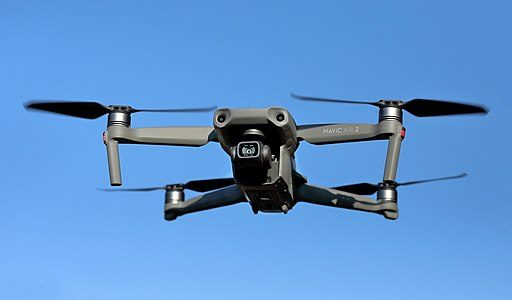The recent implementation of U.S.-China tariffs, including a 34% tariff on Chinese imports and reciprocal measures from China, is creating uncertainty for the drone industry. While the full effects have yet to materialize, experts suggest these policies may lead to higher prices, supply chain disruptions, and shifting market dynamics. Both Chinese manufacturers like DJI and U.S.-based drone companies could face challenges as they navigate these new trade barriers.
Chinese-Made Drones: Price Increases on the Horizon
The tariffs on Chinese imports are expected to raise the cost of drones and accessories in the U.S., with DJI—the dominant player in the market—being particularly affected. Prices for popular models, such as the DJI Mavic series, could rise significantly as importers pass on tariff-related costs to consumers. Accessories like batteries and filters may also see price hikes.
While some retailers have reportedly delayed raising prices by selling pre-tariff inventory, these supplies are limited. Once depleted, consumers may face higher costs for new shipments. Additionally, some DJI shipments are reportedly being delayed at U.S. ports due to Customs inspections under the Uyghur Forced Labor Prevention Act (UFLPA). These delays could lead to temporary shortages of certain models, further complicating availability.
Implications for U.S. Manufacturers
At first glance, the tariffs on Chinese drones might seem like an opportunity for U.S.-based manufacturers to gain market share by narrowing the price gap with competitors like DJI. However, the situation is more complex. Many American drone companies rely on Chinese-made components such as motors, sensors, and rare earth materials.
China’s reciprocal tariffs and export controls on critical materials like samarium and gadolinium could disrupt supply chains and increase production costs for U.S. manufacturers. These challenges may offset any competitive advantage gained from tariffs on finished Chinese drones. Additionally, supply chain delays could slow production timelines for American companies, potentially limiting their ability to meet increased demand.
Supply Chain Disruptions Add Complexity
The global nature of drone manufacturing means that trade tensions between the U.S. and China could have far-reaching effects across the industry:
-
Rare Earth Materials: China’s export restrictions on rare earth minerals may lead to shortages or higher prices for components essential to drone manufacturing, including batteries and electronic systems.
- Production Shifts: Some manufacturers are reportedly exploring alternative production hubs in countries like Vietnam or Mexico to bypass tariffs. However, these transitions take time and may not provide immediate relief from supply chain challenges.
The Impact on Resellers and Service Providers
Paul Rossi, DRONELIFE contributor and CEO of drone and services provider NineTenDrones, said the tariffs have already hit home.
“On February 17, 2025 Nine Ten Drones received notification from distributors that prices on Enterprise and Agras product lines were increasing ‘due to newly implemented tariffs on Chinese goods,’” said Rossi. “Meanwhile, supply issues have lessened, but confusion has reached all time highs…any pricing standards are out the window for a Value Added Reseller that isn’t buying direct from DJI.”
His business has succeeded based on their added value, but Rossi acknowledges that the tariffs have made a shift in focus necessary away from the reseller side. “Nine Ten Drones is no longer able to compete in price against the drop shippers of e-commerce and the big box movers,” he said. “We are maintaining focus on our NC based clients in public safety, education and AEC who value local support and service.”
“We are now in a position that potential clients have to decide if the premium we have to add on top to stay in business is worth the enterprise support that comes with the purchase,” he adds. “End users looking for the cheapest price may need to shop online – but be cautious for who you’re buying from and how you’re paying.”
Market Uncertainty Looms
The combination of tariffs, Customs delays, and supply chain disruptions has created uncertainty for both businesses and consumers in the drone industry. Retailers may adjust their pricing strategies by limiting stock of high-demand items or offering discounts on older models to manage inventory levels. However, if shortages persist or prices rise too sharply, consumers may turn to refurbished or secondhand drones as a more affordable option.
For U.S.-based manufacturers, higher costs for components could constrain innovation or force companies to focus on cost-cutting measures rather than advancing new technologies. At the same time, regulatory scrutiny under measures like the National Defense Authorization Act (NDAA) adds another layer of unpredictability for Chinese-made drones in the U.S.
What Comes Next?
While it is too early to predict the long-term consequences of these tariffs with certainty, several potential outcomes are worth monitoring:
-
Prices for Chinese-made drones may rise significantly in the coming months as retailers adjust to higher import costs.
-
Supply chain disruptions caused by China’s export controls could impact both Chinese manufacturers like DJI and U.S.-based companies reliant on Chinese components.
-
Shifts in consumer behavior—such as increased demand for refurbished drones or domestically produced alternatives—could reshape market dynamics over time.
The current trade environment underscores how interconnected the global drone industry has become. As both Chinese and American manufacturers navigate these challenges, businesses and consumers alike will need to adapt to a rapidly evolving landscape.
Want DRONELIFE news delivered to your inbox every weekday? Sign up here.
Read more:


Miriam McNabb is the Editor-in-Chief of DRONELIFE and CEO of JobForDrones, a professional drone services marketplace, and a fascinated observer of the emerging drone industry and the regulatory environment for drones. Miriam has penned over 3,000 articles focused on the commercial drone space and is an international speaker and recognized figure in the industry. Miriam has a degree from the University of Chicago and over 20 years of experience in high tech sales and marketing for new technologies.
For drone industry consulting or writing, Email Miriam.
TWITTER:@spaldingbarker
Subscribe to DroneLife here.


